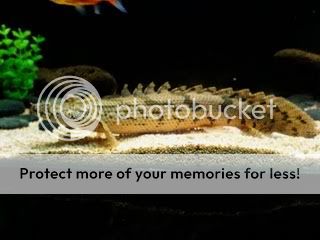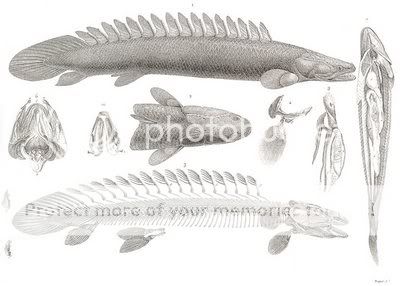- Beranda
- Freshwater Fish
Polypterus A.k.a Palmas Lounge Part II (Ask, Sharing, & Post Your Bichir Here!!!!!)
...
TS
Wyle
Polypterus A.k.a Palmas Lounge Part II (Ask, Sharing, & Post Your Bichir Here!!!!!)
RATE YA BIAR BINTANGNYA BANYAK



Polypterus is a genus of freshwater fish in the bichir family (family Polypteridae) of order Polypteriformes. The type species is the Nile bichir (P. bichir). Fishes in this genus live in various areas in Africa (as the species' common names would indicate). The etymology of the genus name derives from a combination of the Greek prefix πολυ-, poly- (many) and the root word πτερον, pteron (wing or fin) "many fins."
Anatommy
Bichirs are elongated fish with a distinctive series of up to fifteen dorsal finlets, instead of a single dorsal fin. Each of these finlets has a sharp spine. The body is covered in thick, bonelike, ganoid scales. Their jaw structure more closely resembles that of the tetrapods than that of the teleost fishes. Bichirs have a number of other primitive characteristics, including fleshy pectoral fins superficially similar to those of lobe-finned fishes.[1] They also have spiracles.
Bichirs have rudimentary lungs, which allow them to obtain oxygen from the air when in poorly oxygenated waters,[2] by swimming quickly to the surface and back to the bottom. They are nocturnal, and feed on small vertebrates, crustaceans, and insects.[1]
Bichirs have a maximum body length of 97 centimetres (3.18 ft).[3]
There are twelve extant species in two genera:[3]
Spoiler for :
Care and maintenance
Ideally, these fish should be maintained at the higher end of the tropical temperature range, around 25-28oC (77-82oF). Fairly soft to slightly hard water, with a pH around neutral or slightly acidic is probably ideal, but water chemistry is not critical, as long as the water quality is maintained with frequent water changes. The occurrence of two species of Polypterus in Lake Tanganyika (P. ornatipinnis and P. endlicheri congicus) suggests quite different water chemistries can be adapted to. These fish are considered hardy and very tolerant both of poorer water quality and lower temperatures, but it is not wise to test these limits in the aquarium!
Lighting is not overly important unless you opt for live plants. Being mainly nocturnal, the fish are likely to prefer dim lighting, although juveniles in particular do not appear to be bothered by brighter light at feeding time. It may be worth fitting the tank with one of the blue moonlight fluorescent bulbs for an hour or two of evening viewing. Using a timer, this can be set to come on just before the main light goes off, to give a more natural transition to twilight. Increased activity is likely to be observed when the tank is dimly lit, such as from background light in the room.
Polypterus appear to be very hardy fish that rarely suffer from disease. Their tough ganoid scales afford them a degree of protection from the sort of injuries that lead to bacterial or fungal infections, and may also make them more resistant to certain parasites. However, newly imported specimens may be suffering from an infection of a freshwater leech, Macrogyrodactylus polypteri that attaches itself to the body of the fish. The fish may try to seek relief by attempting to scratch itself, behaviour often referred to as flashing or flicking. Formalin baths are effective in removing this parasite. Observe fish carefully before purchase.
Sexual differences in Polypterus are not immediately obvious, but mature males can be identified by their wider and thicker anal fin. It has also been suggested that they have thicker dorsal spines. Females tend to be larger. There are no clear differences in small juveniles. A number of Polypterus species have been bred in captivity, including P. ornatipinnis, senegalus and endlicheri. However, spawning in the home aquarium is still rare.
\tPicture of Polypterus male anal fin

Picture of Polypterus female anal fin

The anal fins of P. s. senegalus

Picture of Polypterus female anal fin

The anal fins of P. s. senegalus
Success is more likely in soft, slightly acidic water. Changes in the temperature and chemistry of the water are likely to be part of the key to inducing spawning. The male cups his anal and caudal fins around the female's genital area to receive eggs for fertilisation, after which the adhesive eggs are scattered. Fine-leaved plants (or spawning mops) should be provided for this. It is generally agreed that the parents and eggs should be separated as soon as possible after spawning, to prevent the eggs (or fry) being eaten. The eggs are about 2-3mm in diameter, and should hatch in about 3-4 days. Feeding should begin after about a week, when the yolk sac has been consumed. Baby brine shrimp (Artemia nauplii) or microworms may prove to be one of the best foods for the new fry, and should be placed as close to the fry as possible, as they are not likely to actively pursue food initially.

0
431.8K
10K
Thread Digembok
Mari bergabung, dapatkan informasi dan teman baru!
Freshwater Fish
1.7KThread•1.5KAnggota
Urutkan
Terlama
Thread Digembok